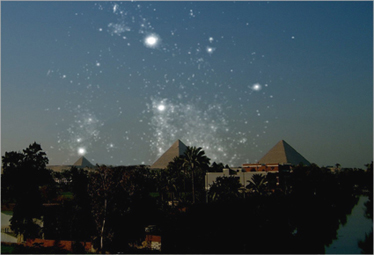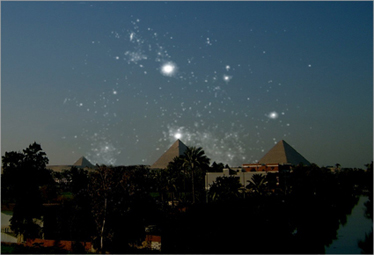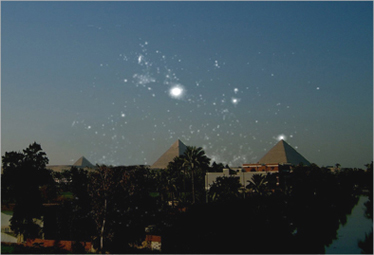It looks like you're using an Ad Blocker.
Please white-list or disable AboveTopSecret.com in your ad-blocking tool.
Thank you.
Some features of ATS will be disabled while you continue to use an ad-blocker.
share:
originally posted by: bigfatfurrytexan
interesting....
I have a hard time wrapping my head around what is basically just an enormous art exhibit. Coming from a time when practicality seemed to be more prevalent.
Assuming the timeline is correct then the resources that went into building these edifices is a difficult thing to grasp ...if it isn't accurate, then an enormous art exhibit / testament to future generations / built as a reminder of the once-golden age it can still actually be.
The golden age, has been theorised to be belonging to a period in pre-history, who knows when (dates have been floated anywhere from 10,000 BCE - 40,000+ BCE) where practicalities took a back seat...which would mean the official timeline refers only to maintenance being carried out on already existing structures around 2,500 BCE, rather than constructing them. The so-called 'golden age of Humanity' would seem to be a fitting theory if the period these structures were built during were of high technology and a carefree existence. The real struggles with civilisation and survival (age of ignorance) probably came much later, after the cataclysmic (meteoric) end of the last ice age, C. 12,000 - 14,000 BCE, until quite recently...if the timeline is incorrect of course.
Note..this is not my theory, but just what i've read and heard on my travels, but could explain why these were built during a seemingly resource dependent, neolithic period.
Stars are in motion .
The link below shows how much the Stars in
the Big Dipper will have moved in another 70k years.
It's pretty substantial on a stellar scale.
pumas.jpl.nasa.gov...
The link below shows how much the Stars in
the Big Dipper will have moved in another 70k years.
It's pretty substantial on a stellar scale.
pumas.jpl.nasa.gov...
originally posted by: UnderKingsPeak
Stars are in motion .
The link below shows how much the Stars in
the Big Dipper will have moved in another 70k years.
It's pretty substantial on a stellar scale.
pumas.jpl.nasa.gov...
Does that programme show how the belt stars would have looked C. 10,000 BCE or further back...i.e. do the belt stars line up perfectly at any other period in pre-history, and if so, approximately what year would that be?
Can you have a look...pretty please?
a reply to: Phage
Thanks again for correcting my spelling mistake, so generous of you.
The documentary i watched all those years ago was done by someone who was far more knowledgeable on the subject than me and he presented it well. It is Not my personal opinion as i have not put in all the hours to clinically research the matter to represent myself as an expert in the field but it was quite convincing.
Graham Hancock explains in the videos that "Precession" of the equinoxes does have a lot to do with dating the building of the Pyramids as the Earth wobbles on it's axis giving a 26 000 year cycle of the stars which states the "precession" of the equinoxes unfolds at 1 degree every 72 years which taken backwards will show a time of around 12 500 years ago when the Pyramids aligned to Orion's belt and match it exactly if i understood it correctly.
You can find excellent documented evidence in the book written by Giorgio de Santillana and Hertha von Dechend in Hamlet’s Mill.
I am not saying Graham Hancock is perfectly accurate but i would i would say he makes a superb case.
Ta ta.
I wasn't sure, when you threw "procession" into it
Thanks again for correcting my spelling mistake, so generous of you.
The documentary i watched all those years ago was done by someone who was far more knowledgeable on the subject than me and he presented it well. It is Not my personal opinion as i have not put in all the hours to clinically research the matter to represent myself as an expert in the field but it was quite convincing.
But the relative motions of the stars is not great enough for anyone to say that any ancient construction which "matched" them then, does not now. As far as Orion's belt goes, they have not changed. They all have essentially the same relative motion (the astronomical term is proper motion). While it is feasible that the layout of the pyramids may represent the stars of Orion's belt, there is no way to use that to date the pyramids.
Graham Hancock explains in the videos that "Precession" of the equinoxes does have a lot to do with dating the building of the Pyramids as the Earth wobbles on it's axis giving a 26 000 year cycle of the stars which states the "precession" of the equinoxes unfolds at 1 degree every 72 years which taken backwards will show a time of around 12 500 years ago when the Pyramids aligned to Orion's belt and match it exactly if i understood it correctly.
You can find excellent documented evidence in the book written by Giorgio de Santillana and Hertha von Dechend in Hamlet’s Mill.
I am not saying Graham Hancock is perfectly accurate but i would i would say he makes a superb case.
Ta ta.
a reply to: UnderKingsPeak
As I said, slight changes over very long periods of time.
As I said, the stars of Orion's belt have the same proper motion (unlike those of Ursa Major) so even over very long periods of time their relative positions change very, very little.
As I said, slight changes over very long periods of time.
As I said, the stars of Orion's belt have the same proper motion (unlike those of Ursa Major) so even over very long periods of time their relative positions change very, very little.
edit on 4/28/2016 by Phage because: (no reason given)
a reply to: southbeach
A "superb case" based on inaccurate information? What?
I am not saying Graham Hancock is perfectly accurate but i would i would say he makes a superb case.
A "superb case" based on inaccurate information? What?
edit on 4/28/2016 by Phage because: (no reason given)
originally posted by: southbeach
a reply to: Phage
Listen!
You are adept at the art of debate but I never mentioned inaccurate information so you are twisting logic to look like you have an argument, did you watch the video?
Inaccurate information:
That the belt stars of Orion ever aligned even near-perfectly with the three main pyramids at Giza.
That precession could somehow cause stars that are not in alignment with the Giza pyramids to occasionally align perfectly (or near-perfectly) with them.
Harte
originally posted by: A51Watcher
My primary point being that the commonly held view that the Pyramids were built to emulate the constellation of Orion appears to be incorrect, and, that we also have a much better candidate.
It is incorrect - but so are other "aligned with the stars" ideas.
There are well over 100 pyramids in Egypt (many of substantial size). Khufu's great-grandfather was the first one to build a pyramid and his father (Sneferu) actually went pyramid-happy and built 3 large ones with a total volume more than the Great Pyramid. By the time Khufu got around to it, they'd been building pyramids for over 200 years and would continue to build them for another 1500 years or so.
If the Orion's Belt idea (or any other alignment) was correct, we would see ALL pyramids of a lineage showing the same Orion pattern.
The crews who worked on Khufu's pyramid included men who'd worked on his father's (and grandfather's) pyramids and Khufu's team worked on Menkaure's pyramid and Khafre's pyramid... but in between those two was the reign of Djedefre, who was indeed building a pyramid... at a short distance away and out of alignment with any Orion idea.
a reply to: A51Watcher
Do you think those images are actual photographs?
So are we to believe then that the alignments shown in the OP are just a huge stroke of luck or coincidence?
Do you think those images are actual photographs?
edit on 4/29/2016 by Phage because: (no reason given)
originally posted by: Phage
a reply to: A51Watcher
So are we to believe then that the alignments shown in the OP are just a huge stroke of luck or coincidence?
Do you think those images are actual photographs?
Whether from photo overlays or charting plots -
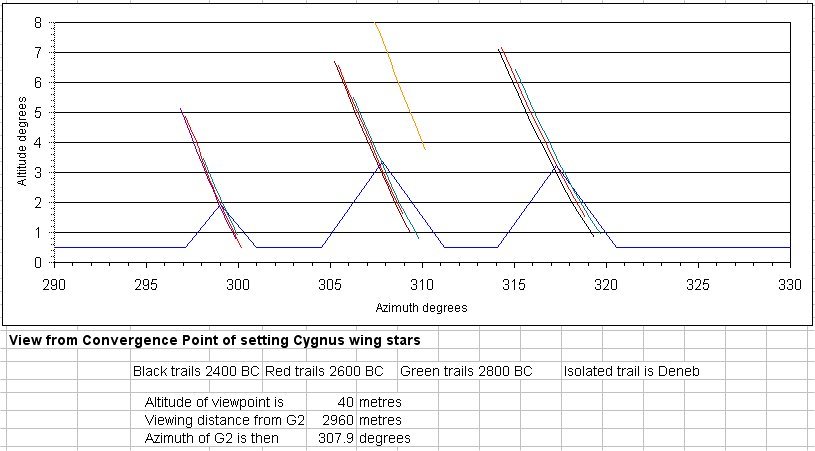
...my question remains is this alignment a coincidence?
a reply to: A51Watcher
My question is, how much fudging of numbers is required to arrive at that "alignment?"
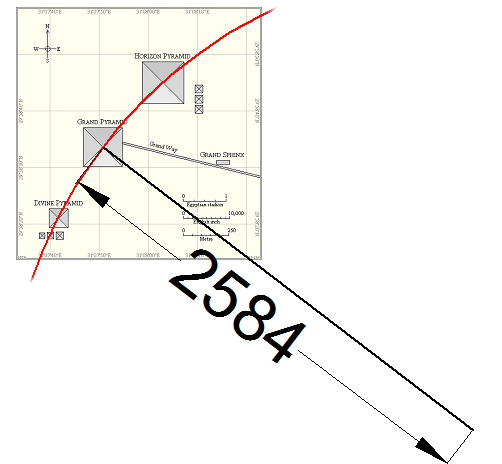
My question is, how much fudging of numbers is required to arrive at that "alignment?"
"A perfect arc of a circle?" Big deal. A circular arc can be defined by any three points that are not in a straight line but the way he puts it sounds much more mysterious, don't you think?
Their three apexes form a perfect arc of a circle
So, they had to adjust that number somewhat to 2,960 meters to make things line up? But I get a different number.
and when the centre of this circle is plotted on a map we find that it falls approximately 2800 m (1.73 miles) southeast of the Second Pyramid

That would make the reverse bearing 322º wouldn't it? That's sort of different from 307.9º, isn't it?
(the azimuth bearing of this sighting line from the Second Pyramid is 142 degrees east of north).
edit on 4/29/2016 by Phage because: (no reason given)
originally posted by: Phage
a reply to: A51Watcher
My question is, how much fudging of numbers is required to arrive at that "alignment?"
That would make the reverse bearing 322º wouldn't it? That's sort of different from 307.9º, isn't it?
(the azimuth bearing of this sighting line from the Second Pyramid is 142 degrees east of north).
Indeed. Apparently fudging numbers is not limited to Hancock but Collins as well.
It must be considered acceptable as long as you have a fall guy to blame the numbers on.
Hancock has Bauval and Collins has Hart.
Thank you for your time and consideration.
originally posted by: A51Watcher
a reply to: Byrd
Thanks for providing your insight.
So are we to believe then that the alignments shown in the OP are just a huge stroke of luck or coincidence?
Thanks
A51
If you check them, you will find that they've been tweaked. Orion has been flipped (for example) to make it work out.
And yes, if you pick any three points you can easily come up with something that mimics Orion's belt. If you wrangled it enough, there are three trees in my yard and my neighbor's yard that would line up with Orion's belt stars.
The pyramids weren't just big blocks dumped out in the desert (as some would have you think) - they were in a huge necropolis (graveyard) and there were walls around each of them and chapels and temples within those walls as well as minor pyramids. It's a whole complex site, not just three things dumped in the middle of the desert.
If Orion had been meant, we would see each succeeding generation aligning their tombs like this (and Djedefre's would have been there on the Giza mount, not off elsewhere). There would be inscriptions about Sah (Orion) found on the site and the other buildings would have been situated to support the idea of the belt stars. There would be one wall around all three pyramids (not three separate walls) and there would have been a permanent astronomical observatory with records there.
..and while someone might hide the records, you can't hide the position of the buildings and walls.
originally posted by: Phage
So, they had to adjust that number somewhat to 2,960 meters to make things line up? But I get a different number.
and when the centre of this circle is plotted on a map we find that it falls approximately 2800 m (1.73 miles) southeast of the Second Pyramid
We should also mention that "meters" weren't used in ancient Egypt. They had cubits, which are NOT meters.
Perhaps they saw a Swan in the Sky and wanted to manifest it on the Earth.
-I
-I
originally posted by: A51Watcher
However....the following photos display a much higher precision as to alignment as we can clearly see.
I would say this would appear to be a much more productive path to explore.
Photos from -
www.andrewcollins.com...
yes indeed
what should be pointed out is the OP link passage which accompanies the 3 images with the 3 stars all 'setting' at the apex of each corresponding pyramid ~ none of which are any of the Orion Belt Stars, a pseudo science fantasy cooked up by a modern day pseudo-scientist that makes money selling fantasy ideas
the passage which explains the 3 photos, with 3 stars 'setting' atop each pyramid, when the viewer is standing at the center of the Arc....
...The importance of this realisation is that when standing at the centre of the arc circle during the Pyramid Age the three Cygnus wing stars would have been seen to set into the peaks of their corresponding Pyramids as defined by the Cygnus-Giza correlation, which we find works in both the vertical and horizontal plane.[...]
what we really need to know for research purposes, is the date and time of the actual 'setting' of each Star at the top of each individual pyramid... then we might be able to flesh out the significance or the possible rituals that were done when these settings occur
RE the OP Link
edit on th30146201684630472016 by St Udio because: (no reason given)
Yes. But, in this case it isn't really relevant. What is relevant is that the radius of the arc described by the pyramids is neither the 2,800 meters claimed in the text of the article nor is it the 2,960 meters used for the "alignment" diagram (I don't know the source of that). What's relevant is that the bearing of 322º given in the text of the article is not the 307.9º used for the "alignment" diagram.
originally posted by: Byrd
originally posted by: Phage
So, they had to adjust that number somewhat to 2,960 meters to make things line up? But I get a different number.
and when the centre of this circle is plotted on a map we find that it falls approximately 2800 m (1.73 miles) southeast of the Second Pyramid
We should also mention that "meters" weren't used in ancient Egypt. They had cubits, which are NOT meters.
The notion is that the layout of the pyramids corresponds to the setting of the stars of Cygnus when viewed from a certain location. The premise is that location is defined by the arc described by the pyramids. The trouble is, the numbers provided by that arc don't work unless you massage them. Which is typical of most "alignment" claims.
edit on 4/30/2016 by Phage because: (no reason given)
new topics
-
Sue Gray, Sir Keir Starmer's former Chief of Staff, Nominated for Peerage
Regional Politics: 1 hours ago -
Biden Nationalizes Another 50,000+ Student Loans as He Heads for the Exit
US Political Madness: 2 hours ago -
An Interesting Conversation with ChatGPT
Science & Technology: 11 hours ago
top topics
-
An Interesting Conversation with ChatGPT
Science & Technology: 11 hours ago, 7 flags -
Biden Nationalizes Another 50,000+ Student Loans as He Heads for the Exit
US Political Madness: 2 hours ago, 4 flags -
Sue Gray, Sir Keir Starmer's former Chief of Staff, Nominated for Peerage
Regional Politics: 1 hours ago, 1 flags
active topics
-
Why isn't Psychiatry involved?
Social Issues and Civil Unrest • 25 • : BrucellaOrchitis -
My personal experiences and understanding of orbs
Aliens and UFOs • 18 • : lilzazz -
Can someone 'splain me like I'm 5. Blockchain?
Science & Technology • 81 • : cherokeetroy -
Drone Shooting Arrest - Walmart Involved
Mainstream News • 34 • : Lazy88 -
Salvatore Pais confirms science in MH370 videos are real during live stream
General Conspiracies • 244 • : Lazy88 -
Mood Music Part VI
Music • 3747 • : lilzazz -
Russias War Against Religion in Ukraine
World War Three • 50 • : Oldcarpy2 -
Sue Gray, Sir Keir Starmer's former Chief of Staff, Nominated for Peerage
Regional Politics • 2 • : gortex -
US Federal Funding set to Expire December 20th. Massive CR on the way.
Mainstream News • 38 • : WeMustCare -
The Truth Behind the Manchester Airport "Police Assault" Video
Social Issues and Civil Unrest • 56 • : Oldcarpy2

